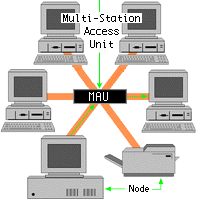Assalamualaikum..
Hello everybusybody~~ :)
Here we are again, learning about network. Let's see what topics we are going to cover for today.
1. Network (LAN) Topology
2. Network Operating System (NOS)
Are you ready for this? *spectacles on*
Network Topology (the title of this post in short form)
is "the study of arrangement or mapping of the elements of a network".
I told you before that I love mind-mapping so this is basically about what is NT.
Physical or topology is the physical layout of devices on a network. It means how each devices is arranged and communicated among each other.
Logical or protocol is the mapping of data flows across networks.
The orange boxes in the mind maps show the examples of each types of NT.
Linear bus
- has a single cable/ backbone- terminator is a must in this topology at the end of the backbone.
| taken from here. |
Ring
- is simple because it has no beginning and end. So, it does not need a terminator. |
| found here. |
Both topology share these characteristics :
- the data is transmitted by going to each station of the node and see whether it has reached to the right destination or not. If it is the wrong destination, the station would be ignored but if it is the right one, the data will be processed.
- the main advantage of this topology is that it requires less cable than a star topology.
- disadvantages of this topology is that if any of the station breaks down, the whole system cannot be used and that it is hard to detect where the problem.
Star
- each network is connected to a central hub.- the hub functions as signal repeater.
 |
| source |
Star-wired
- it may look like it is a star topology.
- the difference is that in the MAU, there's a circle or ring devices that allows information to pass from one to another.
Tree (Hybrid)
- combines linear bus and star topology.- allows the expansion of existing network so it will look like a branches of a tree (backbone like in linear bus topology)
 |
| source |
You might want to take a look at each link that I have put under each image for more information. They are going to be helpful. :)
Besides that, this website is being so informative on cabling which is related to what we have learnt just now. You have to be able to identify which cable is being used in each topology and why is it being used. Ok?
--------------------------------------------------------------
Now, about the NOS.
Major types of NOS is peer-to-peer and client/server.
In peer-to-peer system, the sources are shared among users with no file server which means there's no centralize management. It is always been used in a small area. Besides, users have the equal advantage of this system.
Contrarily, client system consists of what peer-to-peer doesn't. In addition, server is the heart (central management).
For logical NT explanation, this guy has made it simple yet informative. Enjoy! ^_^
Therefore, I rest my case. TEHEE~ :3



0 comments:
Post a Comment